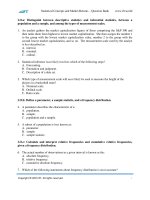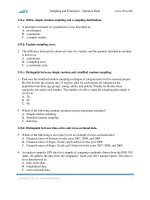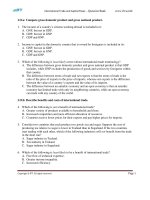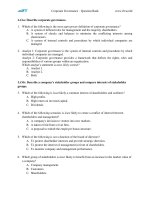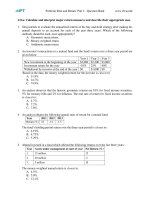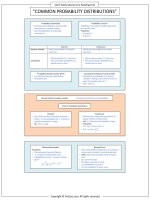CFA 2018 SS 03 reading 11 sampling and estimation
Bạn đang xem bản rút gọn của tài liệu. Xem và tải ngay bản đầy đủ của tài liệu tại đây (160.09 KB, 7 trang )
Sampling and Estimation
2.
Sampling is the process of obtaining a sample from a
population.
Benefits of Sampling:
• Sampling saves time and energy because it is
difficult to examine every member of the population.
• Sampling saves money; thus, it is more economically
efficient.
Two methods of random sampling are:
1. Simple random sampling
2. Stratified random sampling
SAMPLING
Sampling distribution of a Statistic: The sampling
distribution of a statistic is the probability distribution of a
sample statistic over all possible samples of the same size
drawn randomly from the same population.
2.2
Stratified Random Sampling
In stratified random sampling, the population is divided
into homogeneous subgroups (strata) based on certain
characteristics. Members within each stratum are
homogeneous, but are heterogeneous across strata.
Then, a simple random or a systematic sample is taken
from each stratum proportional to the relative size of the
stratum in the population. These samples are then
pooled to form a stratified random sample.
Two types of data:
1. Cross-sectional data
2. Time-series data
NOTE:
Any statistics computed using sample information are
only estimates of the underlying population parameters.
A sample statistic is a random variable.
2.1
Simple Random Sampling
Sampling Plan: Sampling plan is a set of rules that specify
how a sample will be taken from a population.
Simple Random Sample or random sample: A simple
random sample is a sample selected from a population
in such a way that every possible sample of the same
size has equal chance/probability of being selected. This
implies that every member is selected independently of
every other member.
Simple random sampling: The procedure of drawing a
random sample is known as Simple random sampling.
Random sample (for a finite/limited population) can be
obtained using random numbers table. In this method,
members of the population are assigned numbers in
sequence e.g. if the population contains 500 members,
they are numbered in sequence with three digits,
starting with 001 and ending with 500.
Systematic sampling: It is the sampling process that
involves selecting individuals within the defined
population from a list by taking every Kth member until a
sample of desired size is selected. The gap, or interval
between k successive elements is equal and constant.
Sampling Error: Since all members of the population are
not examined in sampling, it results in sampling error. The
sampling error is the difference between the sample
mean and the population mean.
• The strata should be mutually exclusive (i.e. every
population member should be assigned to one and
only one stratum) and collectively exhaustive (i.e. no
population members should be omitted).
• The size of the sample drawn from each stratum is
proportionate to the relative size of that stratum in
the total population.
• Stratified sampling is used in pure bond indexing or
full-replication approach in which an investor
attempts to fully replicate an index by owning all the
bonds in the index in proportion to their market value
weights. However, pure bond indexing is difficult and
expensive to implement due to high transaction
costs involved.
Advantages: Stratified random sampling generates more
precise sample and generates more precise parameters
(i.e. smaller variance) relative to simple random
sampling.
Drawback: Stratified Random Sampling approach
generates a sample that is just approximately (i.e. not
completely) random.
Example:
Suppose, population of index bonds is divided into 2
issuer classifications, 10 maturity classifications and 2
coupon classifications.
Total strata or cells = (2) (10) (2) = 40
• A sample, proportional to the relative market weight
of the stratum in the index to be replicated, is
selected from each stratum.
• For each cell, there should be ≥ 1 issuer i.e. the
portfolio must have at least 40 issuers.
Practice: Example 1,
Volume 1, Reading 11.
–––––––––––––––––––––––––––––––––––––– Copyright © FinQuiz.com. All rights reserved. ––––––––––––––––––––––––––––––––––––––
FinQuiz Notes – 2 0 1 7
Reading 11
Reading 11
2.3
Sampling and Estimation
FinQuiz.com
Important to Note:
Time-Series and Cross-Sectional Data
Time series data: A time series data is a set of
observations on the values collected at different times at
discrete and equally spaced time intervals e.g. monthly
returns for past 5 years.
Cross-sectional data: Cross-sectional data are data on
one or more variables collected at the same point in
time e.g. 2003 year-end book value per share for all New
York Stock Exchange-listed companies.
Panel Data: It is a set of observations on a single
characteristic of multiple observational units collected at
different times e.g. the annual inflation rate of the
Eurozone countries over a 5-year period.
Longitudinal Data: It is a set of observations on different
characteristics of the single observational unit collected
at different times e.g. observations on a set of financial
ratios for a single company over a 10-year period.
• All data should be collected from the same
underlying population. For example, summarizing
inventory turnover data across all companies is not
appropriate because inventory turnover vary among
types of companies.
• Sampling should not be done from more than one
distribution because when random variables are
generated by more than one distribution (e.g.
combining data collected from a period of fixed
exchange rates with data from a period of floating
exchange rates), the sample statistics computed
from such samples may not be the representatives of
one underlying population and size of the sampling
error is not known.
• The data should be stationary i.e. the mean or
variance of a time series should be constant over
time.
Practice: Example 2,
Volume 1, Reading 11.
3.
3.1
DISTRIBUTION OF THE SAMPLE MEAN
The Central Limit Theorem
Standard Error of the Sample Mean =
According to central limit theorem: When the sample
size is large,
1) Sampling distribution of mean (ܺത) will be
approximately normal regardless of the probability
distribution of the sampled population (with mean µ
and variance σ2) when the sample size (i.e. n) is
large”.
Variance of the distribution of the sample mean =
S.D. =
σ
σ2
n
Standard Error of the Sample Mean =
sX =
Standard Error: S.D. of a sample statistic is referred to as
the standard error of the statistic.
When the population S.D. (σ) is known,
n
s
n
where,
s = sample S.D.
The estimate of s =ඥܵܽ݉= ݁ܿ݊ܽ݅ݎܸ݈ܽ݁
s2
And
ݏଶ =
∑ୀଵሺܺ − ܺതሻଶ
݊−1
Finite population correction factor (Fpc): It is a shrinkage
factor that is applied to the estimate of standard error of
the sample mean. However, it can be applied only
when sample is taken from a finite population without
replacement and when sample size of (n) is not very
small compared to population size(N).
2
n
σ
When the population S.D. (σ) is not known,
• Generally, when n ≥ 30, it is assumed that the sample
mean is approximately normally distributed.
2) Sample mean = Population mean
ߤത = ߤ
3) The sampling distribution of sample means has a
standard deviation equal to the population standard
deviation divided by the square root of n.
σX =
( N − n)
Fpc =
( N − 1)
1/ 2
New adjusted estimate of standard error = (Old
estimated standard error × Fpc)
Reading 11
Sampling and Estimation
FinQuiz.com
Practice: Example 3,
Volume 1, Reading 11.
4.
POINT AND INTERVAL ESTIMATES OF THE POPULATION MEAN
Two branches of Statistical inference include:
1) Hypothesis testing: In a hypothesis testing, we have a
hypothesis about a parameter's value and seek to
test that hypothesis e.g. we test the hypothesis “the
population mean = 0”.
2) Estimation: In estimation, we estimate the value of
unknown population parameter using information
obtained from a sample.
Point Estimate: It refers to a single number representing
the unknown population parameter. In any given
sample, due to sampling error, the point estimate may
not be equal to the population parameter.
Confidence Interval: It refers to a range of values within
which the unknown population parameter with some
specified level of probability is expected to lie.
• Sample mean ܺത is an efficient estimator of the
population mean.
• Sample variance s2 is an efficient estimator of
population variance σ2.
• An efficient estimator is also known as best unbiased
estimator.
3) Consistency: An estimator is consistent when it tends
to generate more and more accurate estimates of
population parameter when sample size increases.
• The sample mean is a consistent estimator of the
population mean i.e. as sample size increases, its
standard error approaches 0.
• However, for an inconsistent estimator, we cannot
increase the accuracy of estimates of population
parameter by increasing the sample size.
NOTE:
4.1
Point Estimators
Estimation formulas or estimators: The formulas that are
used to estimate the sample mean and other sample
statistics are known as estimation formulas or estimators.
• An estimator has a sampling distribution.
• The estimation formula generates different outcomes
when different samples are drawn from the
population.
Estimate: The specific value that is calculated from
sample observations using an estimator is called an
estimate e.g. sample mean. An estimate does not have
a sampling distribution.
Three desirable properties of estimators:
1) Unbiasedness (lack of bias): An estimator is unbiased
when the expected value (i.e. sample mean) =
population parameter. The sample variance (i.e.
ത
∑
సభሺ ି ሻ
మ
ିଵ
) is an unbiased estimator of the population
• Unbiasedness and efficiency properties of an
estimator's sampling distribution hold for any size
sample.
• The larger the sample size, the smaller the variance
of sampling distribution of the sample mean.
4.2
Confidence Intervals for the Population Mean
Confidence Interval: A confidence interval is a range of
values within which the population parameter is
expected to lie with a given probability 1 - n, called the
degree of confidence.
• For the population parameter, the confidence
interval is referred to as the 100(1 - α) % confidence
interval.
• The lower endpoint of a confidence interval is called
lower confidence limit.
• The upper endpoint of a confidence interval is
called upper confidence limit.
variance (σ2).
NOTE:
When a sample variance is calculated as Sample
Variance =
ത
∑
సభሺ ିሻ
మ
→ it is a biased estimator because
its expected value < population variance.
2) Efficiency: The efficiency of an unbiased estimator is
measured by its variance i.e. an unbiased estimator
with the smallest variance is referred to as an efficient
estimator.
There are two ways to interpret confidence intervals i.e.
1) Probabilistic interpretation: In probabilistic
interpretation, it is interpreted as follows e.g. in the
long run, 95% or 950 of such confidence intervals will
include/contain the population mean.
Reading 11
Sampling and Estimation
2) Practical interpretation: In the practical interpretation,
it is interpreted as follows e.g. we are 95% confident
that a single 95% confidence interval contains the
population mean.
NOTE:
Significance level (α) = The probability of rejecting the
null hypothesis when it is in fact correct.
Construction of Confidence Intervals: A 100(1 - α) %
confidence interval for a parameter is estimated as
follows:
Point estimate ± (Reliability factor × Standard error)
߯̅ ± ݖ/ଶ
ߪ
√݊
FinQuiz.com
• The reliability factor is based on the standard normal
distribution with mean = 0 and a variance = 1.
Reliability Factors for Confidence Intervals Based on the
Standard Normal Distribution:
• For 90% confidence intervals: Reliability factor = Z 0.05
= 1.65
• For 95% confidence intervals: Reliability factor = Z 0.025
= 1.96
• For 99% confidence intervals: Reliability factor = Z 0.005
= 2.58
Confidence Intervals for the Population Mean (Normally
Distributed Population but with Unknown Variance): In
this case, a 100(1 - α) % confidence interval can be
calculated using two approaches.
where,
Point estimate
= It is a point estimate of the parameter
(i.e. a value of a sample statistic)
Reliability factor = It is a number based on the assumed
distribution of the point estimate and
the degree of confidence (1 - α) for
the confidence interval
1) Using Z-alternative: Confidence Intervals for the
Population Mean-The Z- Alternative (Large Sample,
Population Variance Unknown) is given by:
߯̅ ± ݖ/ଶ
ܵ
√݊
where,
• Z α/2 = Reliability factor = Z-value corresponding to an
area in the upper (right) tail of a standard normal
distribution.
n
Standard error
= Sample size
= Standard error of the sample statistic
• σ = Standard deviation of the sampled population
Precision of the estimator = (Reliability factor × standard
error) → the greater the
value of (Reliability factor ×
standard error), the lower
the precision in estimating
the population parameter.
For example, reliability factor for 95% confidence interval
is stated as Z0.025 = 1.96; it implies that 0.025 or 2.5% of the
probability remains in the right tail and 2.5% of the
probability remains in the left tail.
Suppose, sample mean = 25, sample S.D.
= 20 / √100 = 2. Then,
Confidence interval
• This approach can be used to construct the
confidence intervals only when sample size is large
i.e. n ≥ 30.
• Since the actual standard deviation of the
population (σ) is unknown, sample standard
deviation (s) is used to compute the confidence
interval for the population mean, µ.
2) Using Student’s t-distribution: It is used when the
population variance is not known for both small and
large sample size.
• In case of unknown population variance, the
theoretically correct reliability factor is based on the
t-distribution.
• t-distribution is considered a more conservative
approach because it generates more conservative
(i.e. wider) confidence intervals.
Confidence Intervals for the Population Mean is given
by:
µ = X ± tα/2
25 ± (1.96 × 2) i.e.
• Lower limit = 25 - (1.96 × 2) = 21.08
• Upper limit = 25 + (1.96 × 2) =28.92
Confidence Intervals for the Population Mean (Normally
Distributed Population with Known Variance): In this case,
a 100(1 - α)% confidence interval is given by
߯̅ ± ݖ/ଶ
s = sample standard deviation.
ߪ
√݊
S
n
where,
t= critical value of the t-distribution with degrees of
freedom (d.f.) = n-1 and an area of α/2 in each tail.
tα/2 α/2 of the probability remain in the right tail for the
specified number of d.f.
t-distribution:
Reading 11
Sampling and Estimation
FinQuiz.com
• Like standard normal distribution, t-distribution is bellshaped and perfectly symmetric around its mean of
0.
• t-distribution is described by a single parameter
known as degrees of freedom (df) = n - 1. t values
depend on the degree of freedom.
• t-distribution has fatter tails than normal distribution
i.e. a larger portion of the probability areas lie in the
tails.
• t-distribution is affected by the sample size n i.e. as
the sample size increases → degrees of freedom
increase → the t-distribution approaches the Z
distribution.
• Similarly, as the degrees of freedom increase → the
tails of the t-distribution become less fat.
Z=
x−µ
σ/ n
It follows normal distribution with a mean
= 0 and S.D. = 1.
t=
x−µ
s/ n
It follows the t-distribution with a mean = 0
and d.f = n - 1.
• Unlike Z-ratio, t-ratio is not normal because it
represents the ratio of two random variables (i.e. the
sample mean and the sample S.D.); whereas, Z-ratio
is based on only 1 random variable i.e. sample
mean.
Example:
Suppose, n = 3, df = n – 1 = 3 -1 =2. α = 0.10 →α/2 = 0.05.
Looking at the table below, for df = 2 and for t0.05, tvalue = 2.92.
Basis of Computing Reliability Factors
Sampling from:
Statistic for Small
Sample Size
Statistic for Large
Sample Size
Normal
distribution with
know variance
z
z
Normal
distribution with
unknown
variance
t
t*
Nonnormal
distribution with
known
variance
not available
z
Nonnormal
distribution with
unknown
variance
not available
t*
*Use of z also acceptable
Source: Table 3, Volume 1, Reading 11.
Reading 11
Sampling and Estimation
NOTE:
When the population distribution is not known but
sample size is large (n ≥ 30), confidence interval can be
constructed by applying the central limit theorem.
FinQuiz.com
• Increasing the sample size may result in additional
expenses.
4.3
Selection of Sample Size
The required sample size can be found to obtain a
desired standard error and a desired width for a
confidence interval with a specified level of confidence
(1 - α) % by using the following formula:
Practice: Example 4 & 5,
Volume 1, Reading 11.
n = Z2σ2 / e2
and
n = [(tα /2 ×s) / E]2
Factors that affect width of the confidence interval:
a) Choice of Statistic (i.e. t or Z)
b) Choice of degree of confidence i.e. the greater the
degree of confidence → the wider the confidence
interval and the lower the precision in estimating the
population parameter.
c) Choice of sample size (n) i.e. the larger the n, → the
smaller the standard error, → as a result, the narrower
the width of a confidence interval → the greater the
precision with which population parameter can be
estimated (all else equal).
Limitations of using large sample size:
Practice: Example 6,
Volume 1, Reading 11.
• Increasing the sample size may result in sampling
from more than one population.
5.
• E = Reliability factor × Standard error: The smaller the
value of E → the smaller the width of the confidence
interval.
• 2E = Width of confidence interval.
• As the number of degrees of freedom increases, the
reliability factor decreases.
MORE ON SAMPLING
Sampling-related issues include:
1) Data-mining bias or Data snooping:
Data-mining bias occurs when the same dataset is
extensively researched to find statistically significant
patterns. Thus, data mining involves overuse of data.
Intergenerational data mining: It involves using
information developed by prior researches as a
guideline for testing the same data patterns and
overstating the same conclusions.
Detecting data mining bias: Data mining bias can be
detected by conducting out-of-sample tests of the
proposed variable or strategy. Out-of-sample refers to
the data that was not used to develop the statistical
model i.e. when a variable/model is not statistically
significant in out-of-sample tests, it indicates that the
variable/model suffers from data-mining bias.
Two signs that indicate potential existence of data
mining bias:
a) Too much digging/too little confidence: Generally,
the number of variables examined in developing a
model is not disclosed by many researchers; however,
the use of terms i.e. "we noticed (or noted) that" or
"someone noticed (or noted) that” may indicate
data-mining problem.
b) No story/no future: The absence of any explicit
economic rationale behind a variable or trading
strategy being statistically significant indicate datamining problem.
2) Sample selection bias:
Sample selection bias occurs when sample
systematically tends to exclude a certain part of a
population simply due to the unavailability of data. This
bias exists even if the quality and consistency of the
data are quite high. For example, sample selection bias
may result when dataset exclude or delist (due to
merger, bankruptcy, liquidation, or migration to another
exchange) company’s stock an exchange.
Types of Sample selection bias:
Survivorship bias occurs when the database used to
conduct a research exclude information on companies,
mutual funds, etc. that are no longer in existence.
Self-selection bias occurs when hedge funds with poor
track records may voluntarily do not disclose their
records.
3) Look-ahead bias
Look-ahead bias occurs when the research is
conducted using the information that was not actually
available on the test date but it is assumed that it was
available on that particular day. For example, in price-
Reading 11
Sampling and Estimation
to-book value ratio (P/B) for 31st March 2010, the stock
price of a firm is immediately available for all market
participants at the same point in time; however, firm’s
book-value is generally not available until months after
the start of the year. Thus, price does not reflect the
complete information.
FinQuiz.com
4) Time-period bias:
Time-period bias occurs when the results of a model are
time-period specific and do not exist for outside the
sample period. For example, a model may appear to
work over a specific time period but may not generate
the same outcomes in future time periods (i.e. due to
structural changes in the economy).
Practice: Example 7, Volume 1,
Reading 11 & End of Chapter
Practice Problems for Reading 11.
